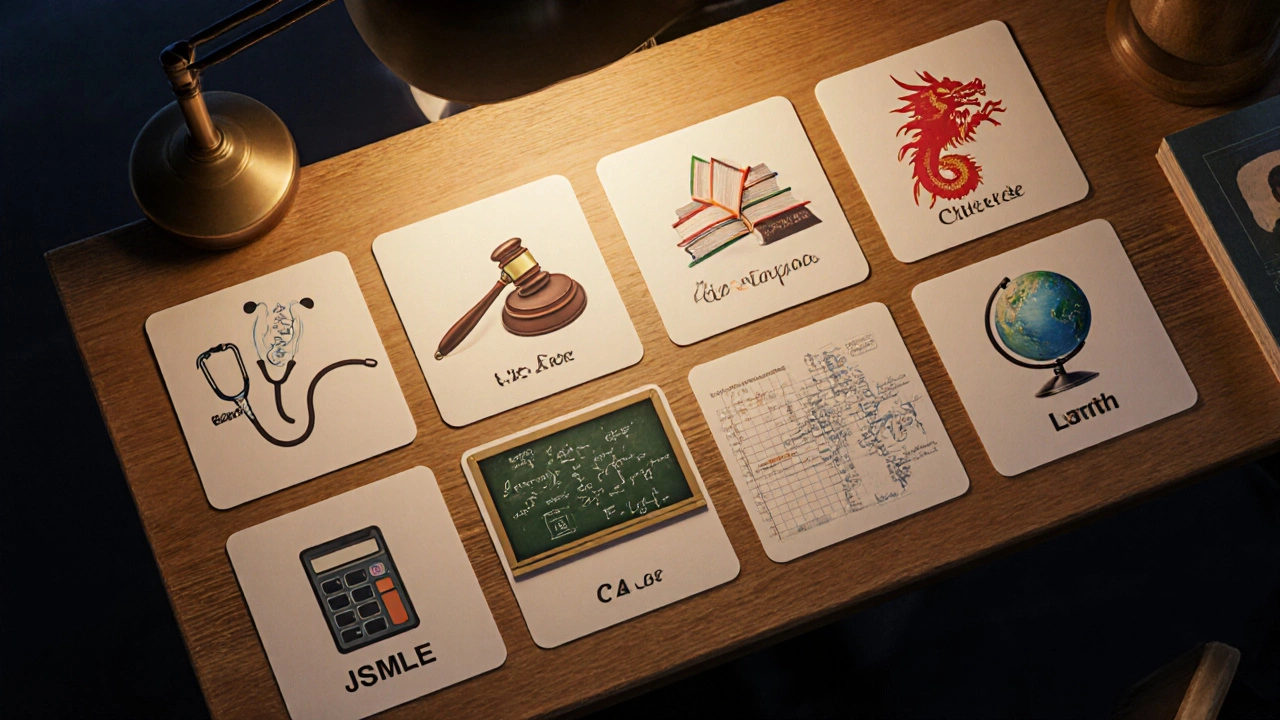
Hardest Exam Pass Rate Comparator
This tool compares the first-time pass rates of the world's most challenging exams. Hover over each exam card to see detailed information.
USMLE Step 1
Medical licensing exam with 96% overall but requires high score for residency.
Civil Service Exam (China)
National exam with 15% pass rate for government jobs.
Bar Exam (USA)
Legal licensing exam with 50-65% pass rate depending on state.
Gaokao (China)
University entrance exam with ~20% pass rate for elite universities.
IIT JEE Advanced (India)
Engineering entrance with ~0.25% pass rate for IIT seats.
CPA Exam (USA)
Accounting certification with 51% pass rate on first try.
CFA Level III
Financial analyst certification with 44% pass rate.
Agrégation (France)
Teacher recruitment exam with ~9% pass rate.
Key Insights
Exams with pass rates below 30% are generally considered among the most difficult globally:
- Extremely Low (< 10%): IIT JEE Advanced (~0.25%), Agrégation (~9%)
- Low (10-20%): Civil Service Exam (15%), Gaokao (20%)
- Medium (20-30%): Bar Exam (50-65%), CFA Level III (44%)
The hardest exams combine high content volume, strict scoring, and high-stakes consequences.
Quick Take
- The exams with the lowest pass rates are typically national professional or university entrance tests.
- China's Gaokao, the U.S. Bar Exam, and the USMLE Step 1 all sit below a 30% pass threshold.
- Difficulty stems from a mix of content breadth, scoring strictness, and high stakes.
- Focused study plans, past paper analysis, and simulated conditions boost success odds.
- Understanding each exam’s structure helps you target effort where it matters most.
When you hear "hardest exam to pass," you probably picture a test where the failure rate barely dips below 20%. But "hard" is a blend of pass‑rate statistics, curriculum depth, and the pressure cooker environment surrounding the exam. This article breaks down the most brutal tests on the planet, explains why they’re so unforgiving, and gives you a practical roadmap if you ever have to tackle one.
How We Rank Exam Difficulty
To keep the comparison fair, we used three measurable criteria:
- Pass rate: The percentage of candidates who clear the exam on their first attempt.
- Scope of knowledge: Number of distinct subject areas or topics covered.
- Scoring strictness: Whether the exam uses absolute cut‑offs, curve grading, or a combination.
Data comes from official exam boards, government education ministries, and recent academic studies published in 2024‑2025. When a pass rate isn’t officially released, we rely on reputable surveys from test‑prep firms that aggregate candidate results.
Top 8 Exams Widely Regarded as the Hardest
Below is a snapshot of each exam, its pass rate, and the key challenge that makes it notorious.
United States Medical Licensing Examination (USMLE) Step 1 is a standardized test that assesses basic science knowledge for medical students in the United States. In 2024, the first‑time pass rate hovered around 96%, but for international medical graduates and students aiming for top residency programs, the required score places the effective pass threshold near the 94th percentile, making it functionally one of the toughest exams.
- Pass rate (overall): ~96%but high scoring requirement pushes many to retake.
- Scope: Anatomy, biochemistry, physiology, pharmacology, pathology, microbiology, genetics.
- Scoring: Purely numeric; no curve, only a fixed minimum score.
Civil Service Examination (China) is a national exam that selects candidates for government positions at various levels. The 2025 data shows a first‑time pass rate of about 15%, reflecting both the volume of examinees and the ultra‑competitive cut‑off.
- Pass rate: ~15%.
- Scope: Political theory, law, public administration, economics, and a writing component.
- Scoring: Rigid cut‑off; only top scorers advance to interview stage.
Bar Exam (United States) is the licensing test for aspiring lawyers. Each state sets its own pass mark, but the overall national average in 2024 was 63%, with states like California and New York dropping below 50%.
- Pass rate: 50‑65% depending on jurisdiction.
- Scope: Constitutional law, contracts, criminal law, torts, evidence, and professional responsibility.
- Scoring: Fixed score threshold; multiple‑choice (MBE) plus essays.
Gaokao (China National College Entrance Examination) is the high‑stakes university admission test for Chinese high‑school seniors. The 2025 national average pass rate for top‑tier universities sits near 20%, while the overall pass‑through for all participants is about 70%.
- Pass rate for elite university admission: ~20%.
- Scope: Mathematics, Chinese literature, a foreign language, and either science or humanities tracks.
- Scoring: Absolute cut‑offs differ by province; intense competition for limited seats.
IIT JEE Advanced (India) is the entrance exam for the Indian Institutes of Technology. In 2025, only about 2.5% of the 200,000 candidates who clear the preliminary JEE‑Main qualify for JEE Advanced, and of those, roughly 10% secure a seat.
- Effective pass rate: ~0.25% for an IIT seat.
- Scope: Advanced physics, chemistry, and mathematics problem solving.
- Scoring: Strict cut‑off plus rank‑based selection.
CPA Exam (United States) is the Certified Public Accountant qualification test. The overall pass rate across all four sections in 2024 was 51% on the first try.
- Pass rate: 51% (average across sections).
- Scope: Auditing, financial accounting, regulation, and business environment concepts.
- Scoring: Minimum scaled score of 75 on each section; no curve.
CFA Level III (Chartered Financial Analyst) is the final stage of the three‑level CFA program. In 2024, the pass rate fell to 44%, the lowest of the three levels.
- Pass rate: 44%.
- Scope: Portfolio management, wealth planning, and ethical standards.
- Scoring: Combination of essay (constructed response) and item‑set questions.
Agrégation (France) is a highly selective competitive exam for French secondary‑school teachers and university lecturers. In 2025, the overall success rate was roughly 9%.
- Pass rate: ~9%.
- Scope: Deep specialist knowledge in a chosen discipline plus pedagogical theory.
- Scoring: Written dissertations, oral defenses, and a series of rigorous written tests.
Pass‑Rate Comparison Table
| Exam | Pass Rate (First Attempt) | Main Challenge |
|---|---|---|
| USMLE Step 1 | 96% overall / 94th percentile required | High numeric cut‑off, massive content volume |
| Civil Service Exam (China) | 15% | Ultra‑competitive cut‑off, political theory focus |
| Bar Exam (USA) | 50‑65% (state dependent) | Complex multi‑format assessment |
| Gaokao | ≈20% for top‑tier universities | High stakes, region‑specific scoring |
| IIT JEE Advanced | ≈0.25% (seat odds) | Extreme problem‑solving speed |
| CPA Exam | 51% (average across sections) | Four separate rigorous sections |
| CFA Level III | 44% | Essay‑type questions demand deep synthesis |
| Agrégation (France) | 9% | Specialist depth plus oral defense |

Why These Exams Feel Unbeatable
Three forces combine to make an exam feel impossible:
- Volume of material: Tests like the USMLE or Gaokao cover entire academic curricula.
- Scoring rigidity: When the cut‑off is a fixed number, a single careless mistake can sink you.
- High‑stakes pressure: The outcome directly determines career entry, so anxiety spikes performance anxiety.
Understanding the root cause helps you target your preparation more intelligently.
Preparing for a Hard Exam: A Practical Blueprint
Even the toughest test can be cracked with a systematic plan. Follow these steps:
- Map the syllabus: List every topic, then rank them by weight in the official exam blueprint.
- Gather elite resources: Use official practice tests, recent exam‑year question banks, and top‑rated prep courses (e.g., Kaplan for the Bar, Bhatia for IIT JEE).
- Build a timeline: Allocate study hours proportionally-spend 40% on high‑weight topics, 30% on medium, 30% on low but tricky areas.
- Practice under real conditions: Simulate the exact time limits, use the same device or paper format, and enforce strict silence.
- Analyze every error: Create an error‑log spreadsheet, note the concept missed, why you missed it, and the corrective action.
- Schedule periodic mock exams: Every two weeks, take a full‑length test and adjust your study plan based on the score trend.
- Mind‑body upkeep: Sleep 7‑8hours, light cardio, and short mindfulness breaks keep cognitive stamina high.
This blueprint works regardless of the exam you’re tackling because it addresses the three forces of difficulty head‑on.
Common Pitfalls and How to Avoid Them
- Over‑relying on flashcards: Useful for memorization but not for applying concepts. Pair flashcards with practice problems.
- Cramming the night before: Neurological research shows retention drops sharply after 24hours without review.
- Ignoring the exam’s format: Skipping essay practice for the Bar or essay‑type CFA questions wastes precious time.
- Studying in isolation: Group discussions expose blind spots and reinforce learning through teaching.
Next Steps: Tailor Your Journey
Pick the exam that aligns with your career goal, then apply the blueprint above. If you’re still unsure which path to take, consider these scenarios:
- Medical aspirant: Start with USMLE Step 1 resources; aim for a score >250 to keep residency options open.
- Government job seeker (Asia): Focus on the Civil Service Exam’s political theory and essay sections; practice timed writing daily.
- Law graduate: Enroll in a Bar‑review course early; allocate 2‑3 hours nightly for MBE questions and 1 hour for essay outlines.
- Engineering hopeful: Join an IIT JEE Advanced mentorship program; solve past papers under timed conditions.
Remember, the hardest exam label is more about preparation gaps than innate impossibility. With data‑driven study, you can flip the odds in your favor.
Frequently Asked Questions
Which exam has the lowest overall pass rate?
The French Agrégation tops the list with a pass rate around 9% in 2025, making it the most selective exam in terms of raw success percentage.
Why is the USMLE Step 1 still considered extremely hard despite a high overall pass rate?
Because residency programs set a high numeric threshold (often >250) that only a small fraction of candidates meet, turning the exam into a de‑facto barrier despite the 96% overall pass figure.
How can I improve my odds for the Bar Exam?
Combine a structured MBE question bank (like BARBRI or Themis) with weekly timed essay practice, and review every mistake within 24hours to cement concepts.
Is there any exam where the pass rate improves significantly after a second attempt?
The CPA Exam shows a jump from ~51% on first try to about 74% on the second attempt, reflecting the benefit of focused remediation between attempts.
Do these hard exams share a common study resource type?
Yes-official past papers and timed mock exams are the most predictive resources across all the exams listed, because they replicate the exact format and difficulty.
Can I attempt these exams without formal coaching?
Self‑study works for some, like the CFA, provided you stick to the official curriculum and allocate at least 300 study hours. For ultra‑competitive exams like IIT JEE Advanced, coaching often supplies the problem‑solving techniques that self‑learners miss.





